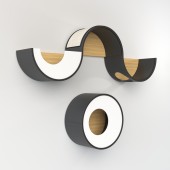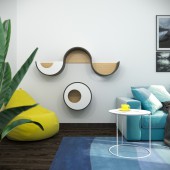
| THE AWARD |
| CATEGORIES |
| REGISTRATION |
| SUBMIT YOUR WORK |
| ENTRY INSTRUCTIONS |
| TERMS & CONDITIONS |
| PUBLICATIONS |
| DATES & FEES |
| METHODOLOGY |
| CONTACT |
| WINNERS |
| PRESS ROOM |
| GET INVOLVED |
| DESIGN PRIZE |
| DESIGN STORE |
| THE AWARD | JURY | CATEGORIES | REGISTRATION | PRESS | WINNERS | PUBLICATIONS | ENTRY INSTRUCTIONS |
Polkota Feline Furniture Module by Nadezhda Kiseleva |
Home > Winners > Design #100562 >Interview |
 |
|
FS: What is the main principle, idea and inspiration behind your design?
NK: The design was inspired by three of my own cats as well as many of my friends' cats. All of them need a well-organized space to play, sleep, relax, and interact with each other.
FS: What has been your main focus in designing this work? Especially what did you want to achieve?
NK: My priority was the aesthetic appeal of the module and its visual versatility, which would allow it to fit seamlessly into almost any interior. Ease of assembly and maintenance was also an important factor.
FS: What are your future plans for this award winning design?
NK: First of all, to make a prototype and try it out on my cats. Then, I will look for a long-term collaboration with producers of pet products so that I can start production and sales and make the module available to as many people as possible.
FS: How long did it take you to design this particular concept?
NK: In total, there were 4 months of work, at a slow pace. Three months of it involved the development of the concept itself and one month of preparation for direct participation in the competition.
FS: Why did you design this particular concept? Was this design commissioned or did you decide to pursuit an inspiration?
NK: There were several concepts during the development process, as usually happens. Specifically, this one was chosen because of its round shape. Firstly, a circle is an ideal, complete shape, and secondly, few people use this shape for such purposes - as a hanging house for a cat. Initially, I did not have the goal of creating a concept that would be put into production, even though all the details, materials, and designs were thought through. However, after the work was done I received a lot of positive feedback from cat owners, which led me to think that it was worth trying to make it happen.
FS: Is your design being produced or used by another company, or do you plan to sell or lease the production rights or do you intent to produce your work yourself?
NK: At the moment, this design is not used by other companies. Ideally, I would like to rent out the production rights or even sell them. In case that does not happen, I will produce it by myself.
FS: What made you design this particular type of work?
NK: I have always liked to develop individual interior details such as furniture or lamps, but my main forté is interior design. So the development of the cat module was a way of implementing it in a related area.
FS: Where there any other designs and/or designers that helped the influence the design of your work?
NK: Before I started, I looked at photos of existing products in the field of pet products to get a clear idea of what already exists, for inspiration, and to avoid accidental repetition. I particularly liked the curved shelf, which was attached to the wall and had a changeable scratching mat.
FS: Who is the target customer for his design?
NK: Cat owners. Especially owners of multiple cats
FS: What sets this design apart from other similar or resembling concepts?
NK: Shape and variability of use. The customer can create a composition for his or her own needs and change it later with minimum effort
FS: How did you come up with the name for this design? What does it mean?
NK: “Polkota” in Russian is a play on words: polka (shelf)+ kot (cat) also means “half of a cat”, which hints at the half-circle form of the module of cats complex.
FS: Which design tools did you use when you were working on this project?
NK: Sketching, firstly, and then software for drawings and 3D-visualization.
FS: What is the most unique aspect of your design?
NK: Variability of possible compositions and ease of usage.
FS: Who did you collaborate with for this design? Did you work with people with technical / specialized skills?
NK: I was collaborating with my friend Ivan Logutov. He is an engineer and helped a lot by developing a hanging detail.
FS: What is the role of technology in this particular design?
NK: First of all, these are modern and eco-friendly materials, without whose existence this design would not have been possible.
FS: Is your design influenced by data or analytical research in any way? What kind of research did you conduct for making this design?
NK: I have conducted online surveys and interviews with several cat owners I know, including face-to-face interviews, observing the cats, so to speak, in their natural habitat.
FS: What are some of the challenges you faced during the design/realization of your concept?
NK: There were technical challenges, such as creating the most user-friendly attachment to the wall and attaching the curved part to the base.
FS: How did you decide to submit your design to an international design competition?
NK: I had a long-lasting desire to participate in an international competition and had a project that could theoretically win. So I just decided to give it a try.
FS: What did you learn or how did you improve yourself during the designing of this work?
NK: I have definitely expanded my knowledge of the pet products market and I already have new developments for another design in the same area.
FS: Thank you for providing us with this opportunity to interview you.
A' Design Award and Competitions grants rights to press members and bloggers to use parts of this interview. This interview is provided as it is; DesignPRWire and A' Design Award and Competitions cannot be held responsible for the answers given by participating designers.
| SOCIAL |
| + Add to Likes / Favorites | Send to My Email | Comment | View Press-Release | Translations |





